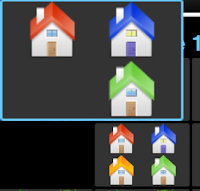This is the game screen. At the top, you'll see a timer counting how long you've been playing and another one counting up your score. Your score is the time it takes you to solve the puzzle, plus a penalty if you use any hints. A lower score is better, and you can upload your score to the online leader-boards to see how well you do against your friends. In between these two numbers is number of your randomly-generated puzzles.
Underneath that, we have the screen where you'll be doing most playing:
When you do this, it automatically removes that color of house from all the other places. You continue removing and promoting items until each space only has one person, one house, one fruit, and one drink in it.
But how do you know which items to remove and which to promote? Well, that's where the clues come in. Underneath the grid is a set of clues for each puzzle:
The clues on the left are very simple. They tell you that the person in the orange house eats strawberries and also drinks coffee. Clues here will always tell you that two things go together in the same house. The clues on the right could tell you a couple things.
 It means that the item on the left has to be left and the item on the right has to be on the right. So in this picture, you would know that the man with the green background has to be to the right of the person who eats peppers. It doesn't, however, mean that they are right next to eachother.
It means that the item on the left has to be left and the item on the right has to be on the right. So in this picture, you would know that the man with the green background has to be to the right of the person who eats peppers. It doesn't, however, mean that they are right next to eachother.
If you see three items in a row, like this: it means that the item in the middle is between (and directly next to) the two items on the side. So in this picture, we know that the blue house is between the house where somebody drinks scotch and the house where somebody drinks coffee. However, the person who drinks coffee could be on the left or the right.
it means that the item in the middle is between (and directly next to) the two items on the side. So in this picture, we know that the blue house is between the house where somebody drinks scotch and the house where somebody drinks coffee. However, the person who drinks coffee could be on the left or the right.
 it means that the item in the middle is between (and directly next to) the two items on the side. So in this picture, we know that the blue house is between the house where somebody drinks scotch and the house where somebody drinks coffee. However, the person who drinks coffee could be on the left or the right.
it means that the item in the middle is between (and directly next to) the two items on the side. So in this picture, we know that the blue house is between the house where somebody drinks scotch and the house where somebody drinks coffee. However, the person who drinks coffee could be on the left or the right.
If you see two items next to eachother, like this: it means that those two items will be next to eachother in the neighborhood, but either one could be on the left or the right.
it means that those two items will be next to eachother in the neighborhood, but either one could be on the left or the right.
 it means that those two items will be next to eachother in the neighborhood, but either one could be on the left or the right.
it means that those two items will be next to eachother in the neighborhood, but either one could be on the left or the right.
Finally, at the bottom of the screen, you will see the options bar:
The + button on the left will refresh Einstein Sudoku and start a new puzzle for you. The undo button will undo a step you've done in the game, and the redo button will undo an undo.
If you get stuck, you can press the "Clue" button. This will either tell you what you can eliminate next. Or, if you made a wrong move, it will tell you how many steps to go back. Don't over-use it, though, because hints will add to your score.
If you forget how to play, the "?" button will give you a quick tutorial, and the last button on the right flips over to the options side of the screen:
From here, you can change the size of the game grid (which will change the difficulty), check your scores against your friends, and find out more about the app.
Happy puzzling!







Looks like a copy of Evertett Kaser's 'Sherlock'.
ReplyDeleteI love this game, as well as the sister apps. Please please update this for iOS 11!
ReplyDeleteI will pay for an updated version of this app. One of the best puzzle games out there. The feel is better than similar apps.
ReplyDelete